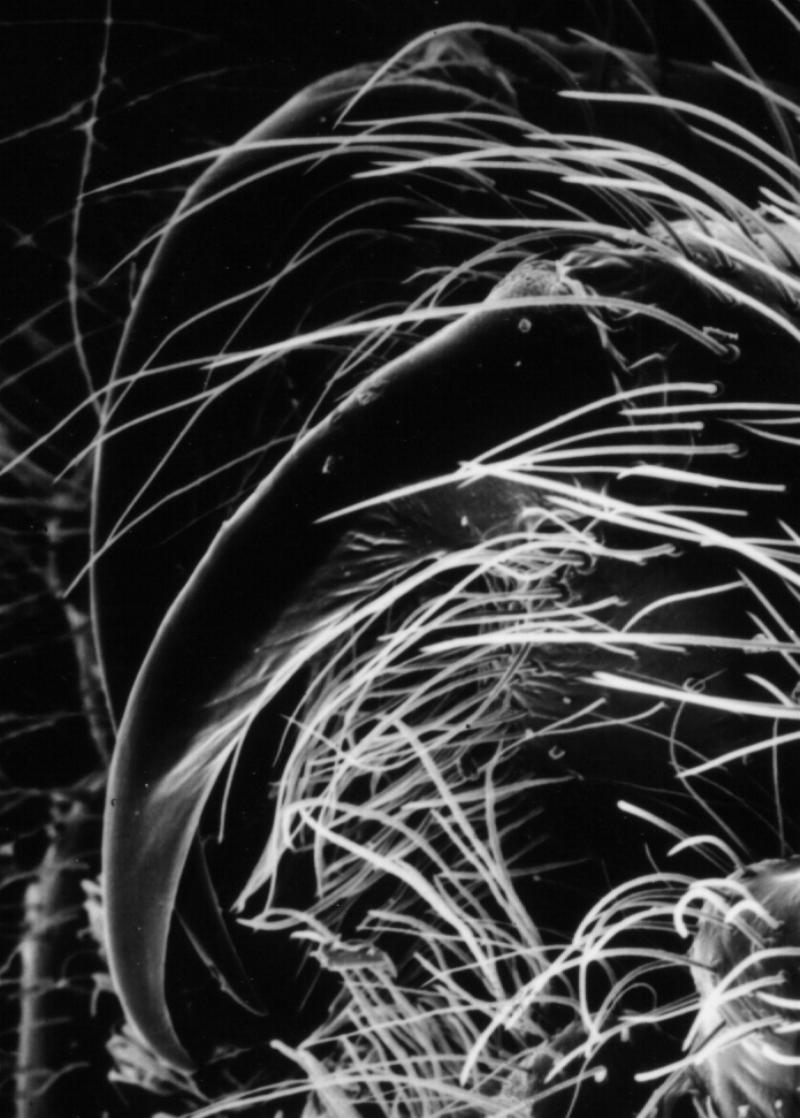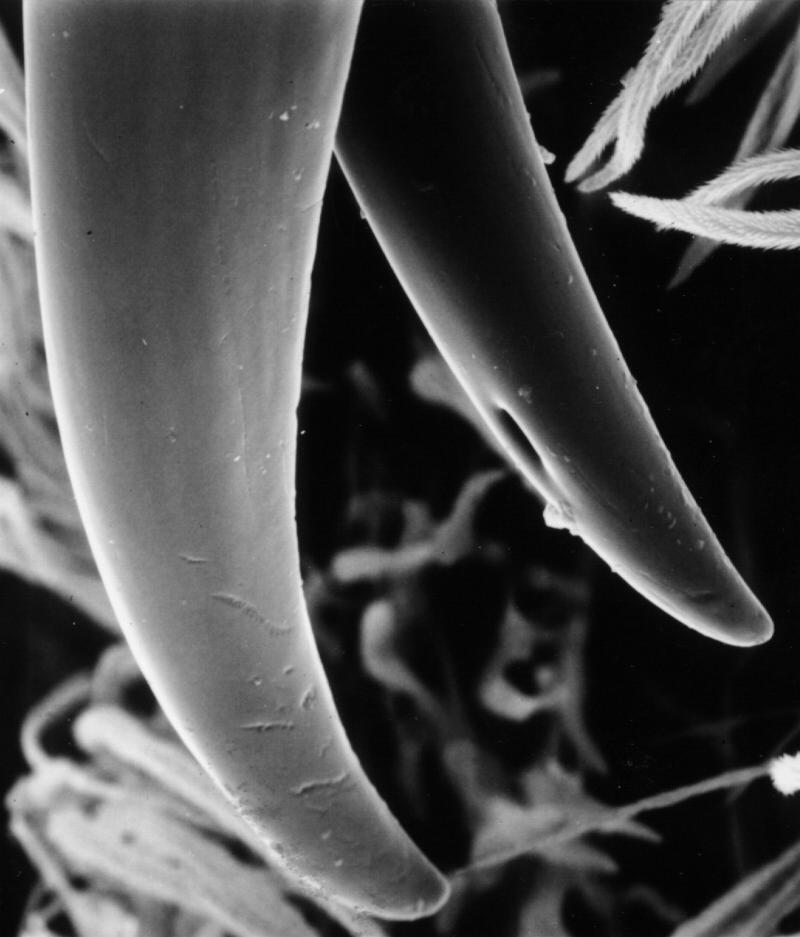FANGLESS
ZOMBIE?
A POSSIBLE EXPLANATION FOR
DAMAGED FANGS AFTER A MOLT
 Scanning electromicrograph (SEM) of the fangs of a third or fourth instar Brachypelma albopilosum. Scanning electromicrograph (SEM) of the fangs of a third or fourth instar Brachypelma albopilosum.
|
 SEM of the fang tips of a third or fourth instar Brachypelma albopilosum. SEM of the fang tips of a third or fourth instar Brachypelma albopilosum.
|
PLEASE, PLEASE, PLEASE
DON'T PASS THIS OFF
AS THE KING'S TRUTH!
THIS IS JUST AN HYPOTHESIS.
It's not been proven, and neither big time scientists nor enthusiasts have had a chance to debate it or test it. So, at the moment it's largely just a lot of hot air. The only reasons we present it are ...
- It seems like a likely explanation.
- By presenting it, perhaps we can convince someone with the expertise and training to seriously look into it.
- If it's ultimately proven true, presenting it now can save a lot of enthusiasts and a lot of tarantulas a lot of inconvenience and suffering.
Use lots of qualifiers if you quote this...
- "Schultz (http://people.ucalgary.ca/~schultz/FanglessZombie.html) thinks that..."
- It's thought by some (but not yet proven, see http://people.ucalgary.ca/~schultz/FanglessZombie.html) that...
- Maybe...
- It's entirely possible that...
- Rumor has it...
- It could be that...
The first two suggestions above are preferable because they place the blame firmly where it belongs (with yours truly), and absolves you of all culpability beyond merely repeating an unproven hypothesis.
|
|
TENDER TOOTSIES
While this really doesn't prove much, there is an interesting correlation at work here. Compare the fangs with almost any other appendage on a tarantula, a leg for instance. Legs are seldom injured by a caged tarantula.
Fangs, on the other hand (no pun intended), are used as shovels and trowels, pick axes, pitons, sabers, battle axes, blenders, hypodermic needles, even love handles! Of all the appendages possessed by a tarantula, the fangs see the most wear and tear, the greatest mechanical stresses, and the most abuse.
Now here is where the story gets a little muddy. While almost every tarantula that has trouble molting has trouble withdrawing one or more of its legs from the old exoskeleton, we have no really good idea of how many times the legs caused the problem, or if the problem wasn't caused by some other primary issue with the stuck leg being a secondary issue.
For instance, if a tarantula suffers a stroke in the midst of a molt (are strokes even possible in tarantulas?), it wouldn't be able to withdraw one or more legs from the old exoskeleton. But, how would we know this? From our ignorant perspective it would APPEAR as though the tarantula had trouble molting because of stuck legs, but the primary cause would have been the invisible stroke.
We may pride ourselves as knowing a lot about these creatures, but OUR IGNORANCE IS STAGGERING.
|
THE ENTHUSIAST'S LAMENT
HELP! HELP! MY TARANTULA JUST MOLTED AND NOW IT DOESN'T HAVE ANY FANGS!
OUR RESPONSE
NOTE THAT THIS CONDITION IS NOT TO BE CONFUSED WITH PALE COLORED (E.G., WHITE, GRAY, PINK, OR RED) FANGS WHICH ARE NORMAL FOR A SHORT PERIOD OF TIME AFTER A MOLT.
This is not an uncommon experience among captive tarantulas. It may be represented by a wide spectrum of deformed, damaged fangs up to and including short stubs or no fangs remnants at all. No one is sure why it happens, but we have a working hypothesis. (But, read the sidebar!)
Since the fangs are used for close-in, hand-to-hand combat with food/prey, they're also the most heavily chitinized appendages in the tarantula's body. It's not too much of a leap of intellect to assume that because of that, they also take the longest time to fully harden after a molt.
If you feed your tarantula too soon after a molt, it's possible that the act of killing and chewing their food damages the internal, "un-set" core of the new fang. But, because it's internal, we can't see any signs of damage. The next time that the tarantula molts, this damaged/bruised/scarred tissue is unable to produce another outer layer of the exoskeleton, and when the older one is cast off, all that's left in place of fangs may be two small stubs. (See Tender Tootsies for an additional comment.)
In order to regenerate the missing fangs the tarantula must experience at least one more molt, possibly a second. If it lives that long.
But, if it's true the defense against it is obvious: DON'T START FEEDING SO QUICKLY AFTER A MOLT! In the past the suggestion was that you should wait a week to 10 days before feeding. Now, we propose a much more conservative approach.
- For 2nd or 3rd Instar babies (i.e., freshly emerged from the eggsac): Wait at least one week before offering them food. Ten days would be a lot better.
- For big, old, fully grown, adult females, wait at least a month before offering them food. Six weeks to two months would be a lot better. Fully grown, adult female goliath birdeater tarantulas (Theraphosa blondi), for instance, have been known to voluntarily undergo two or three full months of fasting both before and after a molt. Think about this: They only eat during six to eight months a year! (This ability/practice becomes important in the discussion below.)
- For intermediate ages, prorate the waiting time according to age or size, but if there are any doubts whatsoever, wait an extra week or two longer.
THIS ALL BEGS THE QUESTION...
"Why do we try feeding them so soon?" The answer is probably that, being homeothermic creatures, WE require comparatively huge amounts of food to maintain an inordinately high metabolic rate and body temperature. We're way out there on the right end of the spectrum, the worst of the food/heat wasters!
We literally plan our lives around our meals. We make weekly pilgrimages to the grocery store to stock up our larder. We pack lunches to school or work. We pack candy bars and snacks when we go on a Sunday day trip. We eat three, four, or five times daily. It's worse than a religion, even worse than an obsession. It's a physiologically mandated addiction acquired through a quarter billion years of evolution! And because this is so much a part of our every fiber, we nod sagely as we pontificate about it, then promptly "lay rubber" to the frig to stoke up again.
And, because eating vast amounts of food in order to maintain such a high metabolic rate has been central to almost our every movement and thought throughout the decades of our lives, without thinking we automatically assume the principle to hold for our tarantulas as well. We are unable to wrap our minds around the concept that there might be animals that operate much, MUCH, MUCH more efficiently than we. Creatures that don't need to eat anywhere near as soon, as often, or as much as we.
So, we feed our tarantulas as though they were canaries, hamsters ... OR HUMANS!
BAD IDEA!
"But, aren't they going to starve to death, the poor dears?" you cry!
NO!
A healthy tarantula can go weeks or months without food, even a year or more. Remember the Theraphosa blondi of a few paragraphs above? The record seems to be something in excess of 3 years for a Chilean rose (Grammostola rosea). Even a very young baby can go without food for several weeks, and big, old, obese females can survive seemingly forever! (Although we don't want you testing this!)
Even if we're wrong with this hypothesis, there's nothing wrong with backing off the gravy train a little. Nothing bad is going to happen if you're more conservative about your feeding schedule after a molt. But, if I'm right, it's going to save you a lot of extra, icky work (see below), if not a valuable and valued pet.
BUT WHAT DO YOU DO NOW THAT IT HASN'T ANY FANGS TO EAT WITH?
You need to supply your tarantula with food that doesn't require mastication. It goes on a baby food diet. While all sorts of weird systems have been proposed, some including puree of cricket and fortified additives, we prefer a more direct, "quick and dirty" technique.
- For this, you're going to require a cricket of appropriate size, a pair of cuticle scissors, a pair of forceps or tweezers, and maybe a pair of rubber gloves. (Note that this link is presented for illustrative purposes only, and is not intended to represent an endorsement or advertisement for any product or entity.)
- Even now, wait the prescribed period of time after the molt before you attempt to feed the tarantula. Remember, if you have any doubts, you can wait a few days longer. The tarantula isn't going to suffer.
- Feed the tarantula only in the evening just before you turn the lights out. Tarantulas generally prefer to be nocturnal feeders.
- Grab the cricket in one hand and snip its head off with the cuticle scissors. (I'm a big softy. I immediately squish the head to make sure it doesn't suffer for long, but dies immediately.)
- Then insert the sharp point of the cuticle scissors into the cricket's neck opening and slit it down most of the body's length. If you want to squeeze a little of the juices out, it's okay. But, you don't have to. (Hint: As soon as possible after each feeding, rinse the cuticle scissors under warm water and dry throughly. They'll be a lot less "icky" the next time you use them!)
- Use the forceps to carefully move the cricket carcass up to the tarantula so as to touch either a pedipalp or a front leg. The slit should be oriented upwards. If you can even get close, the tarantula will know it's there.
- If you can do so without startling the tarantula, you can cover the cage with a towel for even more privacy for the tarantula.
- GO AWAY. LEAVE IT ALONE.
- The next morning you can remove whatever the tarantula has failed to eat.
- Repeat once a week.
Note that it isn't necessary to squish out the cricket's innards, or otherwise manipulate or puree the cricket. The tarantula will eventually learn to merely regurgitate digestive fluids onto the cricket carcass, and imbibe the resulting cocktail.
The good news is that if you can get the tarantula to eat even a little, the prognosis for recovery is very good. Do not be too surprised if the tarantula molts again much sooner than expected. This is a normal mechanism employed by tarantulas to speed the healing process up a bit.
Do not fail to place the cuticle scissors and the forceps in your "Kit" as explained in TKG3 on page 205.
And the rubber gloves? They're for those of you who are faint of heart, weak of stomach, or who simply don't like the idea of touching a cricket, beheaded or otherwise!
"YOU LIKE ZOMBIES? BUY A TARANTULA!"
NAVIGATION
Click the "BACK" button to return to the page from which you came.
Jump to the top of this page.
Jump to the Myths, Misconceptions, Mistakes webpage.
Jump to the Motorhome webpage.
spiders.html">Spiders, Calgary webpage.
Jump to the Index and Table of Contents for this website.
COMMUNICATIONS
Communicating with us is easy. Just select here.
COPYRIGHT NOTICE
Copyright © 2013-April-03, Stanley A. Schultz.
Select here for additional copyright information.
This page was initially created on 2013-April-03.
The last revision occurred on 2013-July-03.

